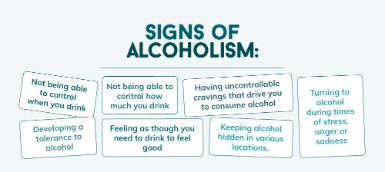The two manuals use similar but not identical nomenclature to classify alcohol problems. At the third stage there are physical and social consequences, i.e., hangovers, family problems, work problems, etc. A person will continue to drink excessively, disregarding the problems. Drinking too much – on a single occasion or long-term – can take a serious toll on your health. Some effects of alcoholmay have a minor effect on your health, while others can be severe or life-threatening. An addiction to alcohol, or alcoholism, when diagnosed is called an alcohol use disorder .The role of corticotrophin-releasing factor in stress-induced relapse to alcohol-seeking behavior in rats. Neuroplasticity in brain reward circuitry following a history of ethanol dependence. Chaudhri N, Sahuque LL, Janak PH. Context-induced relapse of conditioned behavioral responding to ethanol cues in rats. Brady KT, Sonne SC. The role of stress in alcohol use, alcoholism treatment, and relapse.

The study found abstinence from alcohol was the most stable form of remission for recovering alcoholics. There was also a 1973 study showing chronic alcoholics drinking moderately again, but a 1982 follow-up showed that 95% of subjects were not able to moderately drink over the long term. Carol’s past experience in the medical field has led to a deep knowledge of the struggles those with a substance use disorder face. She is passionate about helping people who are struggling with alcohol abuse and addiction and hopes her writing for Alcohol Rehab Guide can help. Choosing to seek help for an alcohol addiction is one of the biggest decisions you will face. There are different forms of treatment available based on frequency and severity of alcohol abuse. Recovering from alcohol addiction is a process that continues long after rehab.
Social Influences
In addition, people who drink heavily may not eat adequately, so they may develop vitamin and mineral deficiencies. Long-term, excessive alcohol use has been linked to a higher risk of many cancers, including mouth, throat, liver, esophagus, colon and breast cancers. Too much alcohol affects your speech, muscle coordination and vital centers of your brain.These include the opioid Endorphin, which makes us feel satisfied and happy. Endorphins are responsible for the feeling of satisfaction you get after exercising. The reward center exists to encourage us to do things the brain deems good for us. Not everyone who binges drinks has an AUD, but they are at higher risk for developing one. To avoid these symptoms, an alcohol-addicted person may begin drinking frequently or nonstop. Over time, these changes to the brain create a vicious cycle of dependence that keeps the person hooked on alcohol. As these changes occur, people tend to require increasingly more significant amounts of alcohol to become intoxicated.
Alcohol Use Disorder
A heavy drinking binge may even cause a life-threatening coma or death. This is of particular concern when you’re taking certain medications that also depress the brain’s function. Some research studies indicate that having bariatric surgery may increase the risk of developing alcohol use disorder or of relapsing after recovering from alcohol use disorder.

Consider talking with someone who has had a problem drinking, but has stopped. Alcohol intoxication results as the amount of alcohol in your bloodstream increases. The higher the blood alcohol concentration is, the more impaired you become. Alcohol intoxication causes behavior problems and mental changes.
Reasons Why People Drink
The American Society of Addiction Medicine reports that in 2016, an estimated 2 million people had substance use disorders involving prescription painkillers, and 591,000 had an addiction that involved heroin. Partial hospitalization programs , the most intensive form of outpatient care, is a level of care that entails patients living at home while attending treatment for up to 10 hours every day, most days of the week. This is a highly supportive and structured form of outpatient treatment. It can be beneficial for those unable to commit to an inpatient stay, but who still require a highly intensive level of care. Inpatient or residential AUD treatment entails patients living and residing in the rehabilitation center 24/7. Inpatient rehab may vary in duration, sometimes consisting of short stays of 3–6 weeks which may or may not be followed by attendance at an outpatient rehab. Some people require longer stays of 6–12 months at facilities known as therapeutic communities , which provide highly structured programming and offer assistance with reintegration into their community.

Alcoholism treatment professionals are seeing some type of trauma in virtually every patient that they treat. There are many forms of trauma, but they all painful events where the victim didn’t have an empathetic witness. For many, treating unresolved trauma is the key to their recovery. 10 Ways To Help An Alcoholic Family MemberEven though things may seem helpless, they aren’t. There are many ways that you can help an alcoholic family member. 5 Risks When Drinking Alcohol In The Summer SunSummer is a wonderful time to go outside and enjoy outdoor activities.The Dietary Guidelines for Americans defines “moderate use” as no more than two alcoholic beverages a day for men and no more than one alcoholic beverage a day for women. It defines a standard drink as one 12-ounce bottle of beer, one 5-ounce glass of wine, or 1.5 ounces of distilled spirits. An inference drawn from this study is that evidence-based policy strategies and clinical preventive services may effectively reduce binge drinking without requiring addiction treatment in most cases. Schematic illustration of how problem drinking can lead to the development of dependence, repeated withdrawal experiences, and enhanced vulnerability to relapse. Alcohol dependence is characterized by fundamental changes in the brain’s reward and stress systems that manifest as withdrawal symptoms when alcohol consumption is stopped or substantially reduced. These changes also are purported to fuel motivation to reengage in excessive drinking behavior.
Risk Factors
These may include inappropriate behavior, unstable moods, impaired judgment, slurred speech, impaired attention or memory, and poor coordination. You can also have periods called “blackouts,” where you don’t remember events. Caucasians have a much lower abstinence rate (11.8%) and much higher tolerance to symptoms (3.4±2.45 drinks) of alcohol than the Chinese (33.4% and 2.2±1.78 drinks respectively). Also, the more acculturation there is between cultures, the more influenced the culture is to adopt Caucasians’ drinking practices. Peyote, a psychoactive agent, has even shown promise in treating alcoholism. Alcohol had actually replaced peyote as Native Americans’ psychoactive agent of choice in rituals when peyote was outlawed.
- Physical addiction occurs once a person is unable to stop drinking without experiencing alcohol withdrawal symptoms, which include anxiety, shakiness, and on the more extreme end, seizures severe shaking, confusion, and hallucinations.
- Learn about the factors that lead to alcoholism and why alcohol is addictive.
- Various forms of individual or group therapy or support groups are used to attempt to keep a person from returning to alcoholism.
- Scientists and researchers have been tracking statistics about alcohol consumption and rates of alcohol-related deaths for decades.
- To report the illegal purchase or consumption of alcoholic beverages by minors by calling1-866-UNDER 21.
- People who have untreated depression, anxiety, or PTSD have a higher risk for alcoholism because they may self-medicate with the drug.
Excessive alcohol use causes damage to brain function, and psychological health can be increasingly affected over time. Social skills are significantly impaired in people suffering from alcoholism due to the neurotoxic effects of alcohol on the brain, especially the prefrontal cortex area of the brain.
Footer Social
This can cause a low platelet count, which may result in bruising and bleeding. Alcohol interferes with the release of glucose from your liver and can increase the risk of low blood sugar . This is dangerous if you have diabetes and are already taking insulin to lower your blood sugar level. “Lexicon of alcohol and drug terms published by the World Health Organization”. ManualNomenclatureDefinitionDSM-IVAlcohol abuse, or Alcohol dependenceAlcohol abuse – repeated use despite recurrent adverse consequences.It is often featured at events or used to celebrate (“toastings,” for example). Many people treat alcohol as a reward at the end of the day or after an achievement, which builds a positive association with alcohol. Alcohol is legal in the United States, and is therefore more accessible than other drugs. Alcohol can be found in homes and at family gatherings, barbecues, restaurants, nightclubs, movie theaters, and resorts, among others. This is available from a range of support groups and professional services.Alcoholism, now known as alcohol use disorder, is a condition in which a person has a desire or physical need to consume alcohol, even though it has a negative impact on their life. Treating alcohol abuse begins by helping the drinker understand that he or she has a problem and needs help. Once a drinker wants to stop, treatment can take place in an outpatient setting or in a hospital inpatient program .Alcohol negatively impacts the brain areas that control balance, memory, speech, and judgment, resulting in a higher likelihood of injuries and other adverse outcomes. Alcoholism also affects the brain’s “reward center” and produces pleasurable sensations when consumed. A new, first-of-its-kind study reveals a key link between alcohol consumption and poor sleep quality in a large sample of men and women. Dopamine levels may make the drinking experience more gratifying.
